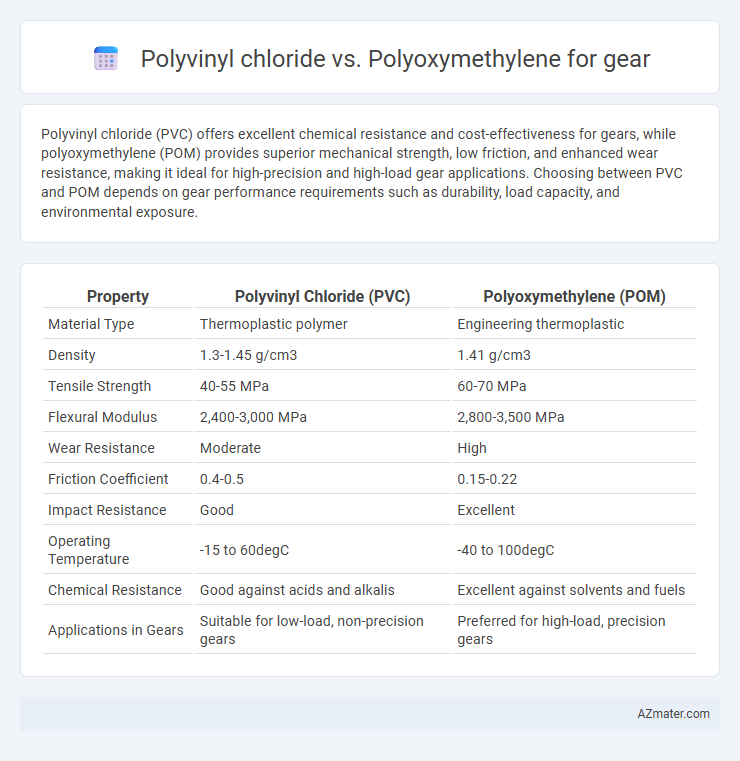Polyvinyl chloride (PVC) offers excellent chemical resistance and cost-effectiveness for gears, while polyoxymethylene (POM) provides superior mechanical strength, low friction, and enhanced wear resistance, making it ideal for high-precision and high-load gear applications. Choosing between PVC and POM depends on gear performance requirements such as durability, load capacity, and environmental exposure.
Table of Comparison
| Property | Polyvinyl Chloride (PVC) | Polyoxymethylene (POM) |
|---|---|---|
| Material Type | Thermoplastic polymer | Engineering thermoplastic |
| Density | 1.3-1.45 g/cm3 | 1.41 g/cm3 |
| Tensile Strength | 40-55 MPa | 60-70 MPa |
| Flexural Modulus | 2,400-3,000 MPa | 2,800-3,500 MPa |
| Wear Resistance | Moderate | High |
| Friction Coefficient | 0.4-0.5 | 0.15-0.22 |
| Impact Resistance | Good | Excellent |
| Operating Temperature | -15 to 60degC | -40 to 100degC |
| Chemical Resistance | Good against acids and alkalis | Excellent against solvents and fuels |
| Applications in Gears | Suitable for low-load, non-precision gears | Preferred for high-load, precision gears |
Introduction to Polyvinyl Chloride (PVC) and Polyoxymethylene (POM)
Polyvinyl chloride (PVC) is a versatile thermoplastic polymer known for its excellent chemical resistance, durability, and cost-effectiveness, making it suitable for various gear applications requiring moderate strength and impact resistance. Polyoxymethylene (POM), also called acetal or polyacetal, is a high-performance engineering thermoplastic characterized by superior stiffness, low friction, and excellent dimensional stability, ideal for precision gears subjected to high mechanical stress. Comparing PVC and POM for gear manufacturing highlights differences in mechanical properties, wear resistance, and application-specific performance criteria.
Key Material Properties of PVC and POM
Polyvinyl chloride (PVC) exhibits excellent chemical resistance and good electrical insulation properties, making it suitable for gears operating in corrosive environments. Polyoxymethylene (POM), also known as acetal, offers superior mechanical strength, high stiffness, and low friction, leading to better wear resistance and dimensional stability in precision gear applications. The choice between PVC and POM depends on factors such as load capacity, environmental exposure, and desired durability of the gear system.
Mechanical Strength Comparison for Gear Applications
Polyoxymethylene (POM) exhibits superior mechanical strength and wear resistance compared to Polyvinyl Chloride (PVC) when used in gear applications, making POM the preferred choice for high-load and precision gears. POM offers higher tensile strength, better dimensional stability, and lower friction coefficients, enhancing gear durability and operational efficiency. PVC, while cost-effective and chemical resistant, lacks the mechanical robustness required for demanding gear performance, limiting its use to lighter, low-stress applications.
Wear and Friction Performance in Gears
Polyoxymethylene (POM) exhibits superior wear resistance and lower friction coefficients compared to Polyvinyl chloride (PVC) when used in gear applications, enhancing durability and efficiency. POM's high crystallinity and low moisture absorption contribute to stable dimensional properties and consistent friction performance under load. Conversely, PVC's softer nature and higher friction generate increased wear, limiting its suitability for high-stress or precision gear environments.
Chemical Resistance: PVC vs. POM
Polyvinyl chloride (PVC) exhibits superior chemical resistance against acids, alkalis, and many organic solvents, making it an ideal choice for gear applications exposed to harsh chemical environments. Polyoxymethylene (POM), while offering excellent mechanical strength and wear resistance, is more susceptible to degradation when exposed to strong acids, bases, and oxidizing agents. In gear manufacturing, PVC's chemical inertness provides enhanced durability in aggressive conditions, whereas POM's chemical resistance is limited to neutral pH environments.
Thermal Stability and Temperature Limitations
Polyvinyl chloride (PVC) exhibits moderate thermal stability with a maximum continuous use temperature around 60-70degC, making it less suitable for high-temperature gear applications compared to Polyoxymethylene (POM). Polyoxymethylene, commonly known as acetal, offers superior thermal resistance with a continuous use temperature up to approximately 90-100degC, ensuring better performance under elevated thermal conditions. This thermal advantage of POM contributes to enhanced dimensional stability and mechanical integrity for gears operating in demanding thermal environments.
Machinability and Manufacturing Process
Polyvinyl chloride (PVC) exhibits moderate machinability with good dimensional stability and ease of cutting, making it suitable for low to medium precision gears in cost-sensitive manufacturing processes. Polyoxymethylene (POM), also known as acetal, offers superior machinability due to its high stiffness, low friction, and excellent wear resistance, which results in precise, high-performance gears with tighter tolerances. Manufacturing processes for PVC gears typically involve injection molding or extrusion followed by secondary machining, whereas POM gears benefit from more advanced CNC machining and post-processing techniques due to their enhanced mechanical properties.
Cost Analysis and Economic Considerations
Polyvinyl chloride (PVC) offers a lower initial material cost compared to polyoxymethylene (POM), making it attractive for budget-sensitive gear manufacturing. However, POM's superior mechanical properties and wear resistance often result in longer gear lifespan and lower maintenance expenses, providing better total cost of ownership in high-performance applications. Economic considerations should weigh PVC's affordability against POM's durability benefits to determine the optimal balance between upfront investment and long-term operational savings.
Typical Applications of PVC and POM Gears
Polyvinyl chloride (PVC) gears are commonly used in low-load applications such as office equipment, household appliances, and toys due to their good corrosion resistance and cost-effectiveness. Polyoxymethylene (POM) gears, also known as acetal or Delrin gears, are preferred in high-performance scenarios like automotive parts, industrial machinery, and precision instruments for their superior mechanical strength, low friction, and excellent dimensional stability. Choosing between PVC and POM depends on the specific application requirements, with PVC suitable for lighter, less demanding tasks and POM ideal for durable, high-stress gear systems.
Choosing the Right Material for Gear Performance
Polyoxymethylene (POM) offers superior dimensional stability, low friction, and excellent wear resistance, making it ideal for precision gears requiring high durability and smooth operation. Polyvinyl chloride (PVC), while cost-effective and corrosion-resistant, typically provides lower mechanical strength and higher friction, which may lead to faster gear wear under heavy loads. Choosing POM over PVC enhances gear performance in high-stress applications by reducing maintenance frequency and improving operational efficiency.

Infographic: Polyvinyl chloride vs Polyoxymethylene for Gear
 azmater.com
azmater.com